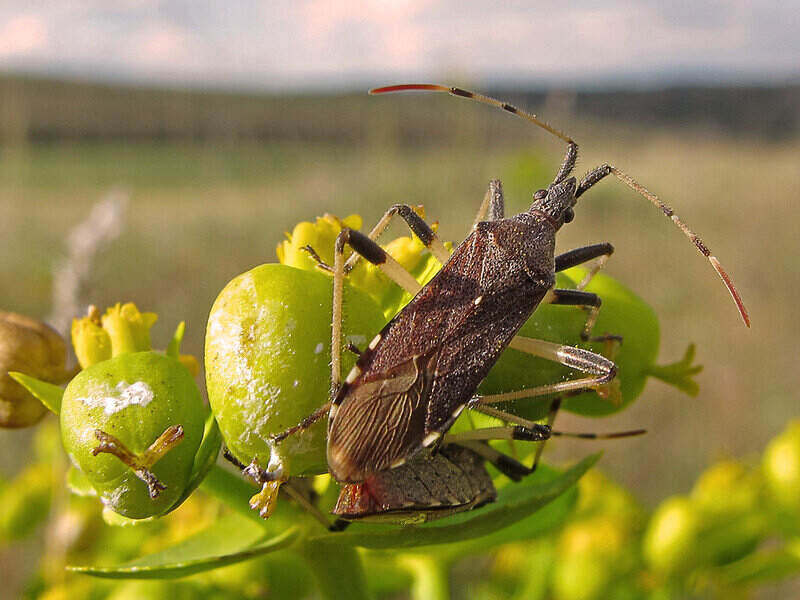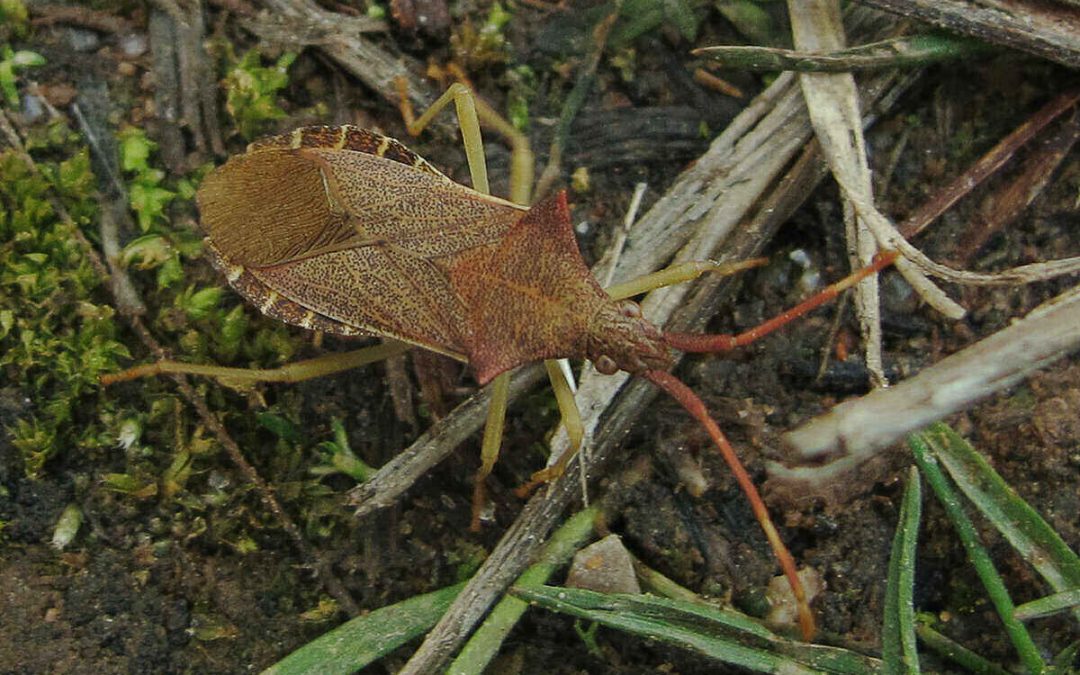Have you noticed dry or dead spots of grass on your lawn? Are you finding yellow patches that turn brown even though your grass is getting plenty of sun and water? Then you may need to know how to get rid of chinch bugs in your lawn.
You can see the tiny black and white (or sometimes reddish-brown) bugs sucking the sap out of your lawn. While they don’t bite people, chinch bugs sometimes mistake hair follicles for blades of grass. That’s when you’ll find yourself scratching your head, trying to figure out how to get rid of chinch bugs in your lawn.
In this article we’ll cover:
- What Are Chinch Bugs?
- How To Spot A Chinch Bug Problem
- How To Get Rid Of Chinch Bugs
- How To Prevent Chinch Bugs
- How To Repair Your Lawn After Chinch Bug Removal
- Chinch Bug FAQs
What are Chinch Bugs?
Adult chinch bugs are less than half an inch long with dark red or black bodies and white wings or clear wings with frosty white tips. Baby chinch bugs or nymphs are much smaller and sometimes orange. They use their pointy mouths or proboscis like a straw to suck the life out of your lawn.
There are 27 varieties of chinch bugs, four of which are common to parts of the United States. The most common chinch bug (blissus leucopterus) infests lawns nationwide, while the southern chinch bug prefers St. Augustinegrass commonly found in Texas and Florida.
How To Spot a Chinch Bug Problem
If you’re not sure if the brown patches in your yard are caused by chinch bugs or drought, check for additional signs:
- Spots of dead grass: The turf turns yellow, then brown. The patches tend to merge into one huge area of dead grass.
- Increase in weeds: Crabgrass and thistle will start to sprout.
- Lawn looks like it’s been through a drought: No amount of water will repair the damage.
- Damage expands rapidly: One brown patch quickly turns into a dozen.
- Neighbors have chinch bugs: The bugs can’t fly but they can walk and hop from one property to the next.
- You can see them: Using a magnifying glass, check the thatch in your lawn. You can also take a sheet of paper and hold it behind blades of grass to make these minuscule bugs easier to spot.
- Tin-can test: Set an open-ended coffee can or metal cylinder 3 inches into the soil. Fill the canister 3/4 full of water and continue to add water to maintain this water level for about 10 minutes. Chinch bugs will float to the top of the water.
How To Get Rid of Chinch Bugs
Chinch bug infestations can be tough to manage. Unlike some pests, they don’t die off in the cold and instead overwinter in your shrubs, bushes, and in the soil. These insects are resistant to many common pesticides. You may have to try several because your grass will not recover on its own.
Natural methods
- Neem oil: This naturally occurring pesticide found in seeds from the neem tree is safe for pets and beneficial insects. Just pour it over the chinch bug-damaged patches and try to avoid the healthy areas.
- Diatomaceous earth: DE causes chinch bugs to lose moisture and die. It comes in a fine powder or dust-like material. When using DE, always wear a dust mask and goggles. Thoroughly water after treating the infested areas.
Chemical/Pesticide method
- Dishwashing or Castile insecticidal soap: Fill a spray bottle with water, and then add two tablespoons of pure liquid soap. (Yes, all soap contains chemicals and is therefore not natural.) In the morning, saturate the damaged patches of grass. Cover treated patches of grass with a flannel sheet. When the chinch bugs attach to it, dunk the sheet into a bucket filled with soapy water.
- Commercial products: Bifenthrin or any insecticide containing carbaryl or pyrethroid will kill chinch bugs. You can use a spreader to disperse granule treatments or buy one with a built-in sprayer.
Chemical pesticides can be a danger for pets. So keep cats and dogs safe by following the directions on the label and keeping them out of the area until the pesticides dry.
How To Prevent Chinch Bugs

The easiest way to prevent chinch bugs and other pests is by maintaining good lawn care practices. Maintaining a healthy lawn keeps the chinch bugs and other lawn-destroying insects away.
- Mow at recommended levels
- Remove thatch: Thatch is a layer of organic matter that settles between the green matter and the soil surface.
- Water consistently: Chinch bugs love drought conditions. Ants and ladybugs are beneficial insects that eat chinch bugs, but heat and drought can lower the number of ants and ladybugs while increasing chinch bug population.
- Aerate and fertilize the lawn: Aeration decreases thatch, which is a breeding ground for chinch bugs.
How To Repair Your Lawn After Chinch Bug Removal
Regular maintenance is just as important when trying to help your lawn recover from chinch bug damage. You’ll need to add a few extra steps to repair the lawn damage.
- Regular mowing will stimulate grass growth. Mow once a week during the growing season, and adjust your mower to cut no more than a third of the grass blade.
- Overseeding your lawn is an easy way to fill in bare spots, improve turf density, and enhance your lawn’s color. You may opt to seed with a more pest-resistant grass type.
- Regular watering in the early morning gives the lawn a chance to absorb the moisture.
- Aerate to remove plugs of grass and soil to make it easier for lawns to take in all the essential nutrients.
- Perform a soil test to make sure your lawn doesn’t have too much nitrogen, which increases chinch bug problems. You can get an at-home soil test kit or take a sample to your local Cooperative Extension office.
- Rake dead patches of grass to prevent thatch buildup.
Chinch Bug FAQ
When the DIY methods and chemical pesticides fail to get rid of the chinch bug problems, it’s time to call in a lawn care professional, not only to get rid of the pests, but to repair the damage and help restore your dream lawn.
Neem oil and insecticidal soaps like Garden Safe and Safe work well. Pesticides containing carbaryl or pyrethroid such as Sevin and Orto Bugclear will also kill chinch bugs.
Yes. Fire ants, spiders, ear wigs, and wasps will help control the chinch bug population in your yard.
In the early afternoon is when you’re more likely to spot chinch bugs on your lawn.
Chinch bugs like hot, drought-like conditions and soil high in nitrogen.
Chinch bugs can infest most grass types, but St. Augustinegrass is their favorite.
Yes. Chinch bugs mistake hair follicles for blades of grass and they will often burrow under a dog’s fur, and insert their sharp mouthparts into the animal’s skin. While this isn’t life-threatening, it does cause uncomfortable itching.
Main photo credit: Jacinta Lluch Valero | Flickr | CC BY-SA 2.0

